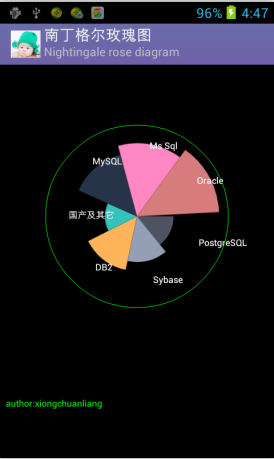編輯:關於Android編程
本文實例講述了Android精靈動畫用法。分享給大家供大家參考。具體如下:
ElaineAnimated.java文件如下:
package net.obviam.walking.model;
import android.graphics.Bitmap;
import android.graphics.Canvas;
import android.graphics.Paint;
import android.graphics.Rect;
public class ElaineAnimated {
private static final String TAG = ElaineAnimated.class.getSimpleName();
private Bitmap bitmap;
// the animation sequence
private Rect sourceRect;
// the rectangle to be drawn from the animation bitmap
private int frameNr;
// number of frames in animation
private int currentFrame;
// the current frame
private long frameTicker;
// the time of the last frame update
private int framePeriod;
// milliseconds between each frame (1000/fps)
private int spriteWidth;
// the width of the sprite to calculate the cut out rectangle
private int spriteHeight;
// the height of the sprite
private int x;
// the X coordinate of the object (top left of the image)
private int y;
// the Y coordinate of the object (top left of the image)
public ElaineAnimated(Bitmap bitmap, int x, int y, int width, int height, int fps, int frameCount) {
this.bitmap = bitmap;
this.x = x;
this.y = y;
currentFrame = 0;
frameNr = frameCount;
spriteWidth = bitmap.getWidth() / frameCount;
spriteHeight = bitmap.getHeight();
sourceRect = new Rect(0, 0, spriteWidth, spriteHeight);
framePeriod = 1000 / fps;
frameTicker = 0l;
}
public Bitmap getBitmap() {
return bitmap;
}
public void setBitmap(Bitmap bitmap) {
this.bitmap = bitmap;
}
public Rect getSourceRect() {
return sourceRect;
}
public void setSourceRect(Rect sourceRect) {
this.sourceRect = sourceRect;
}
public int getFrameNr() {
return frameNr;
}
public void setFrameNr(int frameNr) {
this.frameNr = frameNr;
}
public int getCurrentFrame() {
return currentFrame;
}
public void setCurrentFrame(int currentFrame) {
this.currentFrame = currentFrame;
}
public int getFramePeriod() {
return framePeriod;
}
public void setFramePeriod(int framePeriod) {
this.framePeriod = framePeriod;
}
public int getSpriteWidth() {
return spriteWidth;
}
public void setSpriteWidth(int spriteWidth) {
this.spriteWidth = spriteWidth;
}
public int getSpriteHeight() {
return spriteHeight;
}
public void setSpriteHeight(int spriteHeight) {
this.spriteHeight = spriteHeight;
}
public int getX() {
return x;
}
public void setX(int x) {
this.x = x;
}
public int getY() {
return y;
}
public void setY(int y) {
this.y = y;
}
// the update method for Elaine
public void update(long gameTime) {
if (gameTime > frameTicker + framePeriod) {
frameTicker = gameTime;
// increment the frame
currentFrame++;
if (currentFrame >= frameNr) {
currentFrame = 0;
}
}
// define the rectangle to cut out sprite
this.sourceRect.left = currentFrame * spriteWidth;
this.sourceRect.right = this.sourceRect.left + spriteWidth;
}
// the draw method which draws the corresponding frame
public void draw(Canvas canvas) {
// where to draw the sprite
Rect destRect = new Rect(getX(), getY(), getX() + spriteWidth, getY() + spriteHeight);
canvas.drawBitmap(bitmap, sourceRect, destRect, null);
canvas.drawBitmap(bitmap, 20, 150, null);
Paint paint = new Paint();
paint.setARGB(50, 0, 255, 0);
canvas.drawRect(20 + (currentFrame * destRect.width()), 150, 20 + (currentFrame * destRect.width()) + destRect.width(), 150 + destRect.height(), paint);
}
}
希望本文所述對大家的Android程序設計有所幫助。
 Android中使用Canvas繪制南丁格爾玫瑰圖(Nightingale rose diagram)
Android中使用Canvas繪制南丁格爾玫瑰圖(Nightingale rose diagram)
南丁格爾玫瑰圖 在常規圖表中實在很驚艷,但我初看沒看懂,一查原來南丁格爾這麼偉大,確實值得尊敬。再仔細研究了下這種圖的構成,發現原來就是把柱形圖的柱形換成了扇形圖的半徑來
 Android官方文檔之App Resources(下)
Android官方文檔之App Resources(下)
本文將介紹Android中Resource Types的drawable、menu、layout。如需訪問官方原文,您可以點擊這些鏈接:《Drawable Resourc
 Android 各個版本WebView
Android 各個版本WebView
轉載請注明出處 http://blog.csdn.net/typename/ powered by miechal zhao : miechalzhao@gmail.
 用Canvas和屬性動畫造一只萌蠢的“小鬼”
用Canvas和屬性動畫造一只萌蠢的“小鬼”
最近沒事的時候想自己寫一個支持下拉刷新,上拉加載的自定義View。寫著寫著,就覺得最常見的“一個圈轉啊轉”的進度條太普通了。於是,就想看看有沒有更